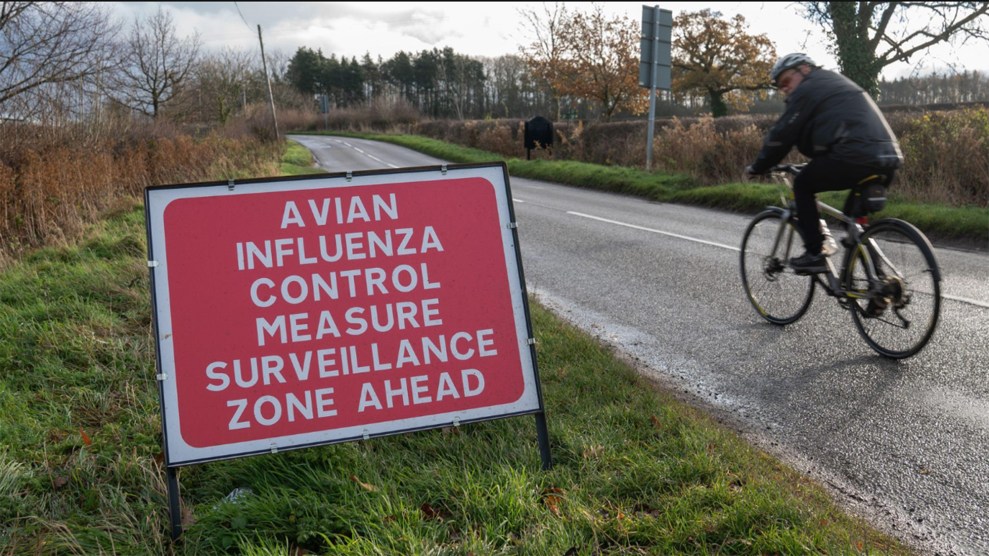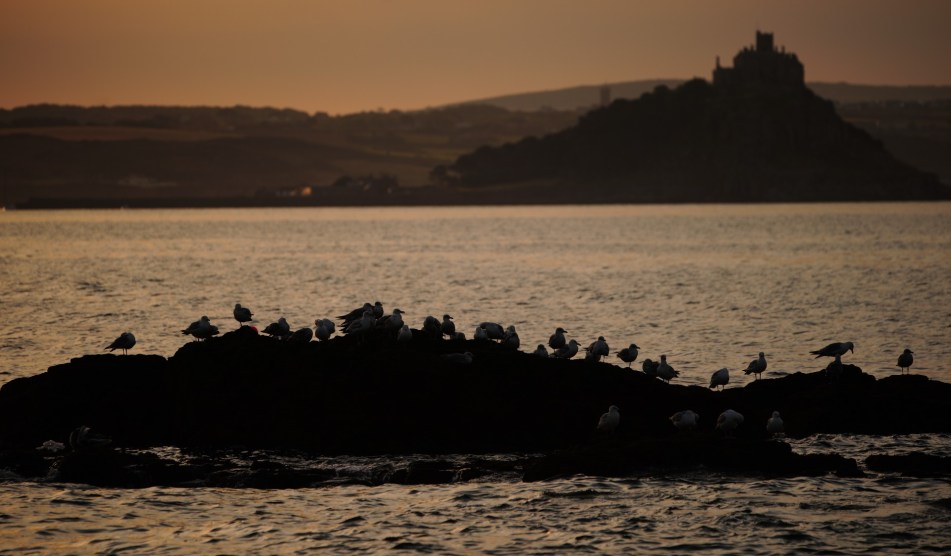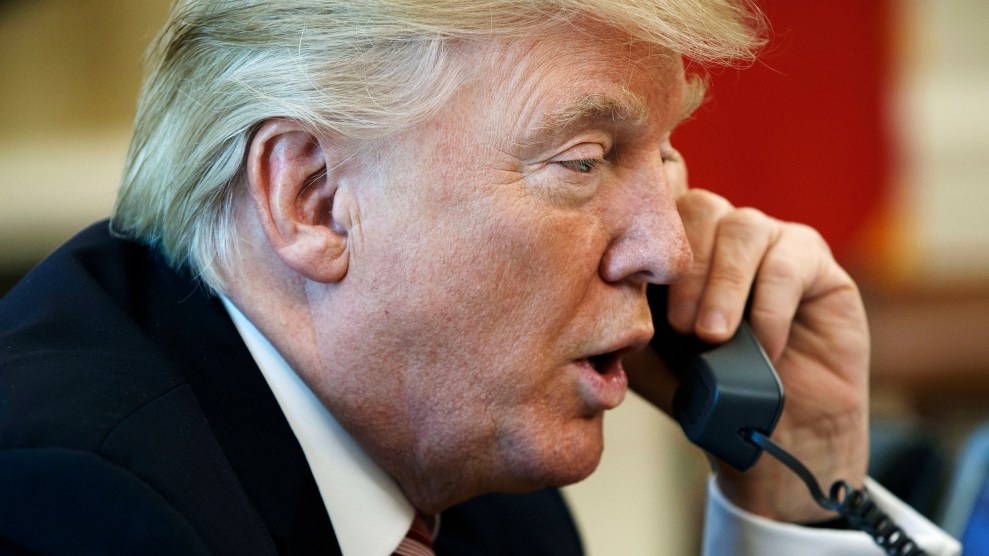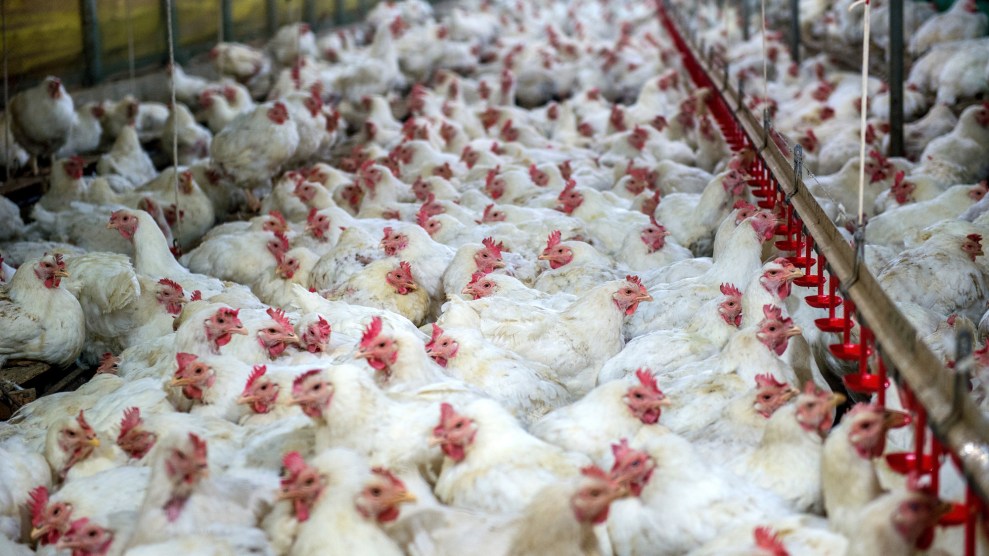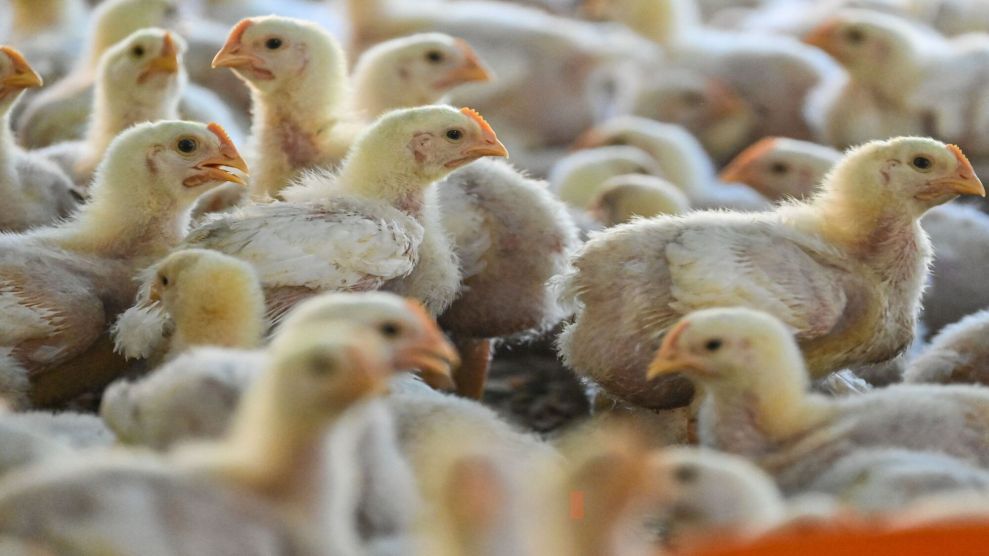
Chicks are seen at a poultry farm.Chaideer Mahyuddin/AFP/Getty
This story was originally published by Wired and is reproduced here as part of the Climate Desk collaboration.
The wave of avian influenza H5N1—which so far has hit 76 countries, triggered national emergencies, and created the worst animal-disease outbreak in US history—keeps roaring through wild birds and commercial poultry. More than 140 million poultry worldwide have died from the virus or were slaughtered to keep it from spreading, according to the World Organization for Animal Health. And though they are harder to count, the die-offs among wild birds have been catastrophic.
Something has to put the brakes on. In the US, where losses are close to 60 million, industry experts are talking quietly about taking a step they have long resisted: vaccinating commercial chickens, laying hens, turkeys, and ducks against the flu.
That doesn’t sound controversial; after all, flu shots for humans are routine, and chickens already receive a handful of vaccinations in the first days of their lives. But only a few countries routinely vaccinate poultry against avian influenza. Introducing a vaccine could trigger trade bans that would crush the enormous US export market, turn sectors of the poultry trade against each other, and possibly provoke consumer uneasiness about food safety.
Officially, therefore, the industry opposes what would be a drastic step. But privately—none would speak on the record—scientists at poultry companies say they see no other exit strategy. And researchers who work alongside the US industry say there may be little choice but to begin vaccination—but also that the US cannot embark on vaccination alone.
“Vaccination is being discussed on a global scale, because it would be a global decision,” says Karen Burns Grogan, a veterinarian and clinical associate professor at the University of Georgia’s Poultry Diagnostic and Research Center. (Georgia produces more broilers, or meat chickens, than any other state, about 1.3 billion per year.) “Everyone from the World Organization for Animal Health, to the US federal government, to trading partners, would have to come to a decision.”
But that decision is by no means guaranteed. Limited stocks of avian vaccines against H5N1 flu were commissioned by the federal government after a huge outbreak in 2015, but they may not curb the currently circulating strain. The US Department of Agriculture has not authorized their use. And expanding the supply enough to protect billions of birds would require a massive manufacturing effort—as well as a significant labor force, because those shots would likely be given by hand.
The discussion is becoming urgent. H5N1 flu keeps infecting humans—most recently, it killed an 11-year-old girl in Cambodia and sickened her father, though the strain they contracted was different from the one currently ripping through birds, and there was no indication the disease spread from them to others. It is rapidly adapting to mammals, most recently killing sea lions off the coast of Peru and minks being farmed in Spain.
H5N1 flu is also killing an uncountable but presumably vast number of wild birds, a change from its historic pattern in which wild birds carried the virus but were not sickened by it. “The impact on wild bird populations is unprecedented,” says Peter Marra, an ornithologist and director of the Earth Commons Institute at Georgetown University. “Massive numbers of gannets and other species have vanished. And this is not just in the US, it’s in the entire Western Hemisphere, throughout Europe, and we assume in Africa.”
And outbreaks in poultry are increasing, even though the industry has tried to harden its biosecurity practices. Those outbreaks represent enormous animal suffering: The fast-moving disease is so gruesome that a prominent expert once called it “chicken Ebola.” Plus, a subset of American veterinarians claims a common method of culling chickens to prevent disease spread—turning off ventilation so that birds die of heat stroke—is cruel. Then, there’s the impact on the food supply: Flock losses just among laying hens last year cut the availability of eggs by 29 percent while doubling prices.
The devastation among those hens hints at complexities that make vaccination challenging. Every type of commercial poultry is allowed to live to a different age depending on its purpose: Broilers grow to full size in six to seven weeks, turkeys take about six months to get to market weight, and layers and broiler breeders (meat chickens’ parents) are allowed to live a year or more, because hens can’t produce eggs until they’re about 26 weeks old. It’s odd but notable that the longer-lived varieties, layers and turkeys, seem to account for more of the losses from flu. (That may partly be an artifact of layer farms housing such huge numbers of animals—millions per property—that the arrival of the virus takes out many more birds.) So it makes sense that egg and turkey operations would benefit the most from vaccines.
But eggs and turkeys don’t account for most of the US international trade in poultry. Broilers do: meat, and also spare bits such as feet that Americans don’t care to consume. Broiler meat exports earned more than $5 billion in 2021, according to the USDA. Meanwhile, multiple countries that buy US chicken have long refused to accept meat from vaccinated broilers, arguing that the immune response to vaccination and flu infection is so similar that safe birds cannot be distinguished from carriers. In other words, the US poultry sector that least needs a vaccine would have the most to risk, economically, from using one.
The intensity of H5N1’s onslaught around the world may be changing that calculus. Last fall an international meeting in Paris explored “removing unnecessary barriers” to avian flu vaccine use. In November, the European Union issued new regulations permitting poultry vaccination under certain conditions; they go into effect this month. Since the beginning of the year, countries in Central and South America, where H5N1 just arrived, have announced they will begin vaccinating poultry.
And late in 2021, the USDA authorized a five-year research project intended to search for new vaccines against avian flu, determine how to prove that they work, and map whether the use of such shots drives the flu virus toward mutations that vaccines would not protect against.
A segment of the flu research community has argued for years that there’s a clear way to distinguish vaccinated birds from infected ones. The strategy, called DIVA (for “differentiating infected from vaccinated animals”), creates a molecular marker by swapping out one protein in whatever circulating strain is used to make the vaccine. When vaccinated chickens are tested, they display antibodies to that substitute strain instead of the wild type, demonstrating that their immunity comes from the vaccine and thus that they are safe to trade. The strategy was twice used in Italy, in 2000 and 2001, to shut down poultry outbreaks caused by flu strains H7N1 and H7N3.
“Other countries always said that the costs attached to vaccination—because of the vaccine itself, but also because of the testing and the potential restrictions on movement—weren’t worthwhile,” says Ilaria Capua, a virologist and senior fellow for global health at Johns Hopkins SAIS Europe in Bologna, who proposed the system’s use in Italy while at the Istituto Zooprofilattico Sperimentale delle Venezie. “But the trade barriers can be nullified if you apply a system that tells you that a flock is vaccinated and has not been exposed to the virus.”
Use of the DIVA system lapsed in Italy because that multiyear wave of H7 strains faded (though not before killing a Dutch veterinarian), and because other countries that were thought to be at risk at the time didn’t have the national budgets or lab capacity to create something similar. The context is different now, given how H5N1 flu has spread worldwide. The number of poultry and wild bird species it has been able to attack isn’t only a measure of the destruction it is wreaking—it’s also a signal that the virus is finding many more hosts in which it can mutate toward more virulent forms.
Experts say recognizing that reality makes poultry vaccination more urgent. It’s always been known that flu spreads from wild birds to domesticated ones, on ponds or in droppings or via small birds that can squeeze past fan covers. But it’s also possible that flu spreads to wild birds in those moments. And while the logistics of vaccinating birds in the wild are unfathomable, vaccinating the ones close to home is within our grasp.
